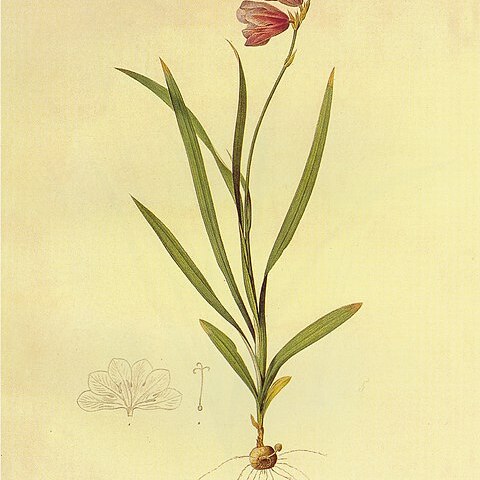Plants 150-300(-500) mm high. Corm subglobose, 10-20(-30) mm diam., with cormlets at base; tunics of fine-textured fibres. Stem erect, simple or up to 2-branched. Leaves 6 to 10, suberect to falcate, lanceolate or sword-shaped, (50-)70-200 x 4-10(-15) mm, acute or subobtuse, with evident main vein, cauline leaves bract-like and often dry. Spike moderately deflexed, subsecund, (2)6-to 10(15)-flowered; bracts dry and papery, whitish or flushed pink but brown and densely speckled with rusty brown in distal 1/2 and on upper margins, outer (8-)10-16 mm long, outer obtuse or 3-toothed with median tooth smaller, inner subequal or slightly shorter, bifid. Flowers subactinomorphic, widely cup-shaped, deep mauve-pink to pale pink or almost white, with dark veins, often dark pink or yellowish at base and lower 3 tepals sometimes with pale pink or yellow line in throat, unscented; perianth tube abruptly funnel-shaped, (8-)12-15 mm long, subfiliform and arcuate in lower 2-4 mm widening abruptly to 7-10 mm diam.; tepals subequal or inner slightly broader, spreading, rhomboid-spathulate to obovate-spathulate, obtuse or minutely emarginate, (16-)20-28 x 8-18 mm, claws with wide hyaline marginal zones, lower 3 sometimes with low ridges along midline. Filaments unilateral but diverging, 8-12 mm long, reaching < halfway up perianth, often pink distally; anthers 5-8 mm long, pale or purple with yellow or mauve pollen. Style 15-20 mm long, dividing opposite middle of anthers, branches 5-6 mm long. Capsules shortly ellipsoid or obovoid-trigonous, 7-8 x 6 mm.
More
A corm plant. It grows 25-40 cm tall. The corm is 2.5 cm across. The leaves are sword shaped. They are 8-40 cm long by 8-24 mm wide. There are 4-10 flowers. The flowers are pink or purple.
Cormous geophyte, 25-40 cm. Leaves sword-shaped. Flowers almost actinomorphic, rotate, with unilateral stamens and style, pink to purple, tepals with lower margins transparent.

